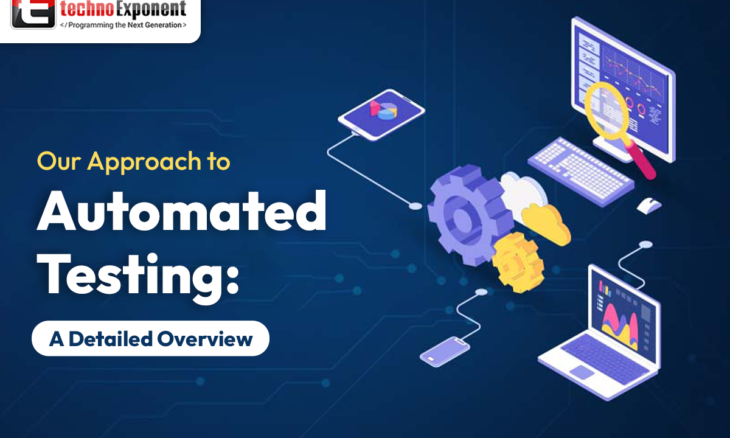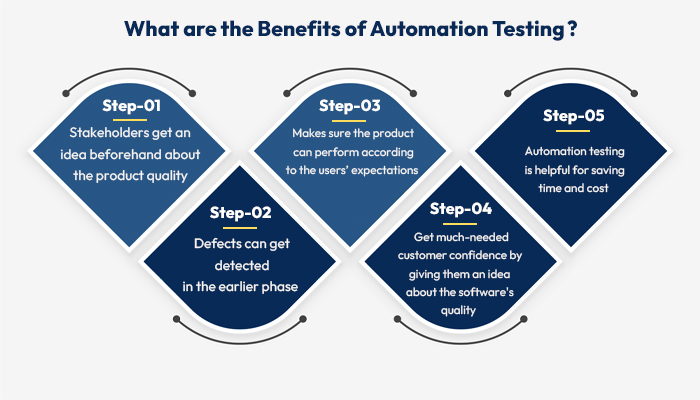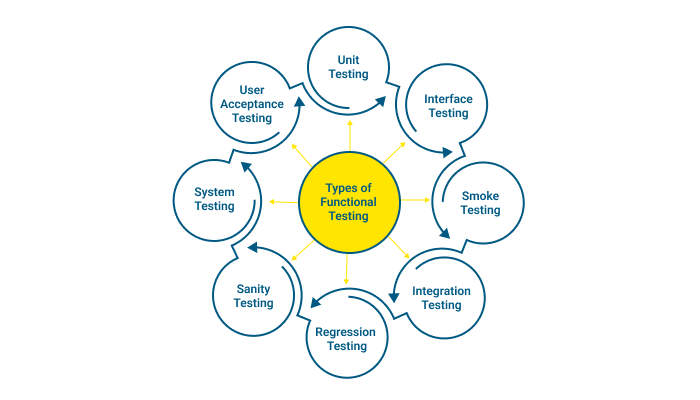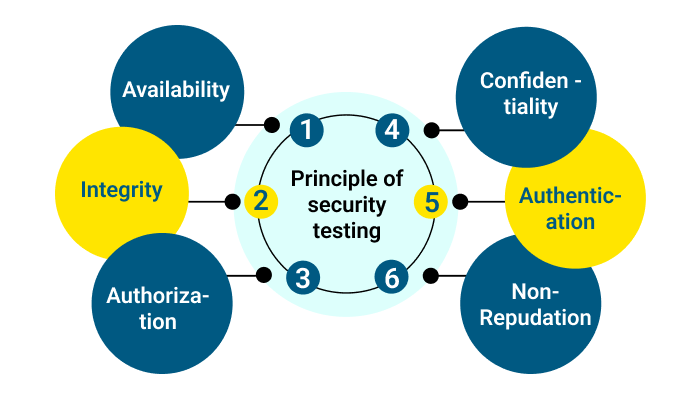
Automated testing uses different tools for smooth test-running and saves from the hassles of manual testing. Better test accuracy, minimal regression time, better test coverage, to easy validation of complex scenarios, you can expect all these benefits from automated testing. When seen from the business perspective, Automated testing saves both time and money.
However, when it comes to our approach to automated testing, we prefer to follow a well-defined and methodical approach. Our testers always focus on providing the best solution that meets clients’ needs the best. Get started after knowing our approach and then check the automated testing services we cover.
Our Approach to Automated Testing
1.Defining The Scope for Testing
We start working after running a feasibility analysis to get an idea of what the testing process needs to achieve. We try to categorize what tests can be done manually and what needs automated testing?
2.Selecting the Right Tool
Selection of the Right Tool The next step we follow. We use advanced test automation tools like Selenium, Cucumber, Cypress, Appium, Jmeter and make their best usage.
- Strategy Design
Then our expert QA engineers work to find the project’s end goal and select the right frameworks to operate test cases. Test automation tools include data-driven, linear scripting, and keyword-driven and modular testing.
- Environment Set Up
Environment setup is a must to get the best test coverage. So, we give a good focus on it and perform the activities like software or hardware installation, test bed scripts development.
- Script Writing
In this stage, our QA engineers prepare scripts for the test performance. We create them considering the client’s needs and standard of scripting.
Open-source tools ( for instance- such as Selenium WebDriver, Appium, and Android Monitor) are great to create automated test scripts and useful for running testing web apps among different devices and programming languages like Python or Java.
- Test Execution
GUI and API testing are the two most popular ways for test automation. GUI is a popular type that imitates the user experience and can run manner each time and in every iteration tests several software features. API testing checks the app programming interface and asses the third-party or in-house APIs.
- Report Analysis
Automated tools provide the report after the completion of execution.

Automated Testing Services We provide
Automated testing can be categorized into two categories, including functional and non-functional testing. We provide testing on each of these areas. Find more details here.
Functional Testing
The goal of this testing approach is to do proper verification and validation of the basic software-related functionality. Functional testing can be considered black box testing as the testers need to delve into a project without checking its internal structure. Functional testing checks individually whether each part app feature can match the requirement of the software.
Types of functional testing we are offering:
- Unit testing
As the name says, this testing process checks the individual software unit to ensure the desired functionality. We do this following the right techniques and carry the tests to test-driven environment before passing them to the testing team. We automate the manual testing process instead of doing this manually and provide the benefits like a quicker development cycle, detection of problems at the early phase in SDLC, etc.
- Smoke Testing
We provide relevant smoke testing that gives an idea about the stability of deployed software. It is like a confirmation from the QA team that gives the green signal to proceed further with the software testing. Our testers follow a standard smoke testing approach and verify the functionality of the significant features. Smoke testing saves time, effort, and resources and ensures no flaw in the code.

- Integration Testing
Our professional integration testing ensures each software is integrated with each other in command or DB calls form. With our integration testing, we focus on maintaining flawless integration and desired software operation.
API testing is a part of integration testing that focuses on the validation of two systems working together in conjunction. The business logic layer conducts this testing and direct messaging conducts it via the message layer.
Some common API testing types we provide are Functional testing, security testing, load testing, runtime error detection, user interface testing, and validation testing.
Web APIs belong to the web services category like Simple Object Access Protocol (SOAP ) or Representational Access Protocol ( REST). And now, GraphQL ( A query language for API), also got popular. It uses URL- based REST APIs, or XML that offers output data in JSON, CSV, or RSS formats.
REST API aims to check the accuracy of the HTTP status code and also check the overall performance time. Fundamental positive tests are its parts, and security or authorization check is there also.
- System Testing
With our methodical system testing approach, we focus on evaluating the functionality of the earlier completed integrated systems and assure the software needs the specific needs.
- Regression testing
Our testers perform flawless and thorough regression testing to make sure the earlier modified functionalities or codes don’t get introduced any defect in the new code. Besides, through the regression testing, we make earlier functionalities don’t hamper the new fixes. Our quality regression testing ensures any impact of the enhancement will not affect the existing app quality badly.
- Sanity Testing
We do this subset of regression testing to make sure even a minor issue is not hampering the code quality. After this testing, we can assure made changes are performing properly.
- User Acceptance Testing
This final phase of functionality testing guarantees your final product is ready to get released. We do this testing and enable users to get software that meets their specific business needs perfectly. To identify any type of functionality issue, we run this testing both internally by the test team and end users.
- Interface Testing
Our testers perform interface testing for evaluating the data passing and control between the components. This process verifies every interaction between modules are working properly.
Non-Functional Testing We Cover
1.Usability Testing
Usability testing gives an idea about the end users’ experience before reaching them to users. At Techno Exponent, we provide an effective usability testing solution that checks the ease of use from the end user’s perspective. It is performed at the later stage of the SDLC and it aims to look for any aesthetic flaws in any app. Testing usability has different subsets and each one of them validates five basic areas, including, content, identity, accessibility, navigation, and portability.
2.Performance testing
The name of this test presents its purpose. We perform performance testing to check the performance monitors like stability, responsiveness, scalability, and speed of software. Load testing, spike testing, endurance testing, and stress testing are the top components of performance testing.
Load testing checks the performance of software under added load and checks the performance of the app in a real-world situation.
Spike Testing is a part of load testing that checks the performance of an app both in increased or decreased load over the varied time limit.
Stress testing checks the performance of an app under an excessive load that goes beyond the expected load and looks for the failure point of the software.
Endurance testing or Soak testing checks how an app can perform under sustained usage.
3.Security Testing
It is the need of the hour as security threats are increasing at an alarming rate. Finding the security gap in security that may lose confidential information by breaking the firewall of an app is the motto of this testing. Different types of security testing include network penetration tests, assessing security vulnerabilities and app security tests. We do rigorous security testing to keep your valuable data protected.

4.Compatibility Testing
This non-functional software testing is crucial to make sure an app can perform successfully. You will get a top-notch compatibility test from our experienced back-end team. This testing guarantees to offer smooth performance across different websites.
5.Agile Testing
We follow the agile methodology, and in this testing, we bring the testing and development teams together to quicken the product delivery process. Agile testing creates a collaborative environment among testers, developers, and business analysts who continue to give relevant feedback on the fixed and quality defects.
Agile Methodology Types:
There are two agile methodology types
Scrum
Scrum methodology is the most popular and widely used agile methodology. The Scrum team comes with:
- Business Stakeholders
- Product Owner
- Scrum Master
- Developers
- Testers
- Automation Engineers
Continuous learning and improvement are the base of scrum framework. This process follows an iterative approach and teams can get adapted to the changing user needs, tests reprioritizing that offer continuous improvement.
Software Testing Tools We Use
For Functional testing, we use the tools like:
- Selenium
- Cucumber
- Cypress
- Appium
- Jmeter
- Loadrunner
- Postman
- Neoload
Non-Functional testing Tools We Use
- Apache JMeter
- LoadRunner
- NeoLoad
- Test Management Tools:
- JIRA
- Trac
- TestLink
- Bugzilla
- Mantis
- Test Rail
Cloud tools We Use
- Jenkins
- Bitbucket
- GitLab
- Gradle
- Maven
Final Words
Find the effective software testing services from the leading software testing company with valuable industry experience! And present the best product with confidence before your client that will meet their expectation level.
 +44 141 628 8980
+44 141 628 8980
 (786) 269-2247
(786) 269-2247
 +61 872007153
+61 872007153
 +91 8900027268 (Sales only)
+91 8900027268 (Sales only)








